Methodological Proposal for the Study of Temporal and Spatial Dynamics during the Late Period between the Middle Ebro and the Pyrenees
Abstract
1. Introduction
2. Archaeological Data from My Study: Problems and Limits
2.1. The Documentary Base of the Corpus
2.2. Between the Roman and Visigoth Periods: A Disparity in Documentation
2.3. General Characteristics of the Documentation
- In general, I can say that the data are scattered, partial, and incomplete.
- Great variety of work scales, ranging from the isolated study of a set of materials found by chance (for example, San Blas in Olite) to the well-documented excavation of others (the case of El Mandalor).
- Scarce data on some sites due to the lack of publication of the results compared to others that have unpublished memoirs, specific articles, and even monographs.
- Differences in the quality and quantity of data in the administrative reports, in some cases with only the coordinates and in others with hundreds of detailed pages with the materials collected, plans and photographs.
- Vague and imprecise chronologies, especially for the Visigothic period. Resolutions ranging from half a century to more than two centuries.
- Great heterogeneity in the dates of data capture. From discoveries in the 19th century without other later mentions to recently found sites because of preventive archaeology.
- Different techniques for collecting the data, with few spaces and sites where I have prospecting and excavations. In most cases, I have survey data, but the sites where I have both are minimal.
- Different coordinate systems. In general, this is a minimal problem; most sites have WGS84 coordinates on the administration’s archaeological maps or inventories, which are compatible with the ETRS89 system of web applications such as Iberpix (a cartographic viewer of the Government of Spain that aims to facilitate the location and visualization of places in the national territory).
3. Database Lifecycle Management: Applying a Business Data Model to Archaeology
3.1. The Collection of Archaeological Data
3.2. Data Management: My Database Management System (SGBD)
4. Vagueness Management
5. Time Management
6. Multiple Categories for the Same Settlements
7. THE GDB Data Model: From the Archaeological Entity to the Archaeological Functional Unit
- Is it feasible to record all the structures for each phase or do I not have enough data? Do I have the material time to do so? Will entering them in the database provide me with significant results?
- Do I go down to the structure level or do I look for an intermediate point between the site and the structure?
- What if I look for a way to integrate the isolated findings separately from the sites themselves, perhaps by making a table with different variables for each one?
8. Conclusions
Funding
Conflicts of Interest
References
- Del Arco, R. Excavaciones en MonteCillas, Término de Coscojuela de Fantova (Huesca); Junta Superior de Excavaciones y Antigüedades: Madrid, Spain, 1921. [Google Scholar]
- Del Arco y Garay, R. Nuevos Restos Romanos Hallados en Coscojuela de Fantova (Huesca). Boletín la Real Acad. la Hist. 1919, 75, 127–142. [Google Scholar]
- Altadill, J. De Re Geographico-Histórica. Vías y Vestigios Romanos en Navarra. In Homenaje a Carmelo Echegaray; Diputación de Guipúzcoa: San Sebastián, Spain, 1928. [Google Scholar]
- Escalada, F. La Arqueología en la Villa de Javier (Navarra). Boletín la Real Acad. la Hist. 1934, 104, 269–286. [Google Scholar]
- Escalada, F. La Arqueología en la villa y Castillo de Javier y sus Contornos; Leyre: Pamplona, Spain, 1943. [Google Scholar]
- Serra Ràfols, J. La Villa Fortunatus, de Fraga. Empúries Rev. Món Clàssic i Antig. Tardana 1939, 5, 5–35. [Google Scholar]
- Fatás Cabeza, G.; Plácido, D.; Cepas Palanca, A. Tabvla Imperii Romani, k30; Ministerio de Cultura: Madrid, Spain, 1993.
- Cepas, A.; Guitart i Duran, J.; Fatás Cabeza, G. Tabvla Imperii Romani K/J-31: Pyrénées Orientales, Baleares. Tarraco, Baliares.; Consejo Superior de Investigaciones Científicas: Madrid, Spain, 1997. [Google Scholar]
- Cepas Palanca, A. Crisis y Continuidad en la Hispania del Siglo III; Anejos del Archivo Español de Arqueología; CSIC: Madrid, Spain, 1997.
- Tudanca Casero, J.M. Evolución Socioeconómica del Alto y Medio Valle del Ebro en Época Bajoimperial Romana; Instituto de Estudios Riojanos: Logroño, Spain, 1997.
- Paz Peralta, J.Á. La Antigüedad Tardía. Caesaraugusta 2001, 75-2, 539–592. [Google Scholar]
- Castiella Rodríguez, A. Por los Caminos Romanos de Navarra; Caja Navarra: Pamplona, Spain, 2003. [Google Scholar]
- Sesma Sesma, J.; García García, M.L.; Garcia Gazólaz, J.; Prieto Vinagre, J.J.; Faro Carballa, J.A.; García Jaurrieta, D.; Castiella Rodríguez, A. Poblamiento y Territorialidad en la Cuenca de Pamplona: Una Visión Arqueológica. Cuad. Arqueol. la Univ. Navarra 1999, 7, 1–309. [Google Scholar]
- Andreu Pintado, J. Epigrafía Romana de Santa Criz de Eslava (Eslava, Navarra); Fratelli Lega Editori: Faenza, Spain, 2019. [Google Scholar]
- Armendáriz, R.M.; Mateo, M.R.; Sáez de Albéniz, M.P. Prospección del Término Municipal de Eslava (Navarra). Isturitz 1997, 7, 145–163. [Google Scholar]
- Armendáriz Aznar, R.M.; Jusue Simoneda, C. Bases Para el Conocimiento del Poblamiento Romano en el Curso Medio del Río Cidacos (Navarra). In Crónica del XX Congreso Arqueológico Nacional; Secretaría General de los Congresos Arqueológicos Nacionales: Santander, Spain, 1991; pp. 385–392. ISBN 84-600-7775-6. [Google Scholar]
- Chasseigne, L. Prospection dans le piémont pyrénéen: Le nord du somontano de Barbastro (Huesca) à l’époque romaine. Saldvie2 2002, 2, 177–194. [Google Scholar]
- Chasseigne, L. Informe de las prospecciones arqueológicas realizadas en el territorium labitolosanum. 014.2000. 2001. Available online: https://www.researchgate.net/publication/38292531_Arqueologia_de_la_comarca_de_Zafra-Rio_Bodion_y_alrededores_resultados_de_las_prospecciones_arqueologicas_desarrolladas_en_el_suroeste_de_Badajoz (accessed on 15 July 2020).
- Andreu Pintado, J.; Jordán Lorenzo, Á. Epigrafía, organización del territorio y poblamiento en territorio de Vascones: Los Bañales (Uncastillo, Zaragoza). Espac. Tiempo y Forma, Ser. I, Prehist. y Arqueol. 2004, 16–17, 419–461. [Google Scholar] [CrossRef]
- Andreu Pintado, J.; Lasuén Alegre, M.; Lorenzo, Á.A.J. El poblamiento rural en el territorium de la civitas vascona de Los Bañales en época romana. Trab. Arqueol. Navarra 2009, 21, 121–160. [Google Scholar]
- Jordán Lorenzo, Á.A. Memoria de las prospecciones arqueológicas en el término municipal de de Sos del Rey Católico (Zaragoza). Septiembre-noviembre 2016. 2016. Available online: http://www.culturanavarra.es/uploads/files/2_Andreu%20TAN21WEB.pdf (accessed on 15 July 2020).
- Departamento de Educación y Cultura (Ed.) Arqueologia Aragonesa.1991; Departamento de Educación y Cultura: Zaragoza, Spain, 1994.
- Departamento de Educación y Cultura (Ed.) Arqueología Aragonesa: 1993; Departamento de Educación y Cultura: Zaragoza, Spain, 1997.
- Departamento de Cultura y Educación (Ed.) Arqueología Aragonesa, 1986–1987; Departamento de Educación y Cultura: Zaragoza, Spain, 1991.
- Departamento de Educación y Cultura (Ed.) Arqueología Aragonesa: 2006; Departamento de Educación y Cultura: Zaragoza, Spain, 2007.
- Departamento de Educacion y cultura (Ed.) Arqueologia Aragonesa.1992; Departamento de Educación y Cultura: Zaragoza, Spain, 1994.
- Departamento de Educación y Cultura (Ed.) Arqueología Aragonesa 1988–1989; Departamento de Educación y Cultura: Zaragoza, Spain, 1991.
- Royo, J. Excavaciones en la villa de Cuatrón de la Pesquera. In Arqueología Aragonesa 1985; Departamento de Educación y Cultura, Ed.; Departamento de Educación y Cultura: Zaragoza, Spain, 1987; pp. 249–251. [Google Scholar]
- Trément, F. Les Arvernes et Leurs Voisins du Massif Central à L’époque Romaine Tome 1; Société des Amis des Universités de Clermont-Ferrand: Clermont-Ferrand, France, 2013. [Google Scholar]
- Parga Dans, E.; Valera Pousa, R. Caracterización de la arqueología comercial en españa. Complutum 2014, 22, 9–25. Available online: https://digital.csic.es/bitstream/10261/103597/1/DISCO_arqueologia_comercial_Espa%C3%B1a.pdf (accessed on 15 July 2020).
- Laliena, C.; Ortega, J. Arqueología y Poblamiento. La Cuenca del río Martín en los Siglos V - X; Universidad de Zaragoza: Zaragoza, Spain, 2005. [Google Scholar]
- Martín Viso, I.; Melgar, P.F.; Blanco, J.C.S.; Ramos, R.C. (Eds.) Cerámicas Altomedievales en Hispania y su Entorno (siglos V-VIII d.C.); Arbotante Patrimonio e Innovación: Valladolid, Spain, 2018; ISBN 9788494795244. [Google Scholar]
- Monnier, J. Les établissements ruraux de l’Antiquité tardive en Suise. In Les Campagnes de la Gaule à la fin de L’Antiquité; Ouzoulias, P., Pellecuer, C., Raynaud, C., Van Ossel, P., Garmy, P., Eds.; APDCA: Antibes, France, 2001; pp. 173–199. [Google Scholar]
- Gandini, C. Des campagnes gauloises aux campagnes de l’Antiquité tardive la dynamique de l’habitat rural dans la cité des Bituriges Cubi: (IIe s. av. J.-C. - VIIe s. ap. J.-C.), FERACF. 2008. Available online: https://www.persee.fr/doc/antiq_0770-2817_2012_num_81_1_3821_t13_0627_0000_2 (accessed on 15 July 2020).
- Aranda González, R. Cerámica de época visigoda: Una historia de la investigación. An. Prehist. y Arqueol. 2014, 30, 71–94. [Google Scholar]
- Ariño Gil, E.; Dahí, S.; Sánchez, E. Patrones de ocupación rural en el territorio de Salamanca. In Visigodos y Omeyas: El Territorio; Caballero Zoreda, L., Mateos Cruz, P., Cordero Ruiz, T., Eds.; Anejos del Archivo Español de Arqueología: Mérida, Spain, 2012; pp. 123–145. [Google Scholar]
- Paz Peralta, J.Á. Ceramica de mesa romana de los siglos III-VI d.C. An. Prehist. Arqueol. 1991, 30, 25. [Google Scholar]
- Zuza Astiz, C.; Zuazúa Wegener, N.; García-Barberena Unzu, M. Un tipo cerámico característico de la Pamplona de los siglos VI y VII. In Cerámicas Altomedievales en Hispania y su Entorno (Siglos V-VIII d.C.); Martín Viso, I., Fuentes Melgar, P., Sastre Blanco, J.C., Catalán Ramos, R., Eds.; Arbotante Patrimonio e Innovación: Valladolid, Spain, 2018; pp. 84–103. ISBN 9788494795244. [Google Scholar]
- Zuza Astiz, C.; Zuazúa Wegener, N.; García-Barberena Unzu, M.; Unzu, M. “Pompelo” y el siglo III, pautas singulares de consumo cerámico a través del contexto estratigráfico hallado en el edificio no 47 de la calle Estafeta. Trab. Arqueol. Navarra 2016, 28, 73–97. [Google Scholar]
- Iriarte Kortazar, A. Algunos elementos de cultura material tardorromana procedentes de la “villa” de San Blas (Olite, Navarra). Cuad. Arqueol. la Univ. Navarra 2000, 8, 197–206. [Google Scholar]
- Aguilera Aragón, I. La ocupación tardorromana de la cueva del Moro. Bolskan 1996, 13, 133–137. [Google Scholar]
- Vadoudi, K.; Bratec, F.; Troussier, N. GIS-oriented lifecycle management for sustainability. In Proceedings of the IFIP Advances in Information and Communication Technology, Ghent, Belgium, 30 May–1 June 2016; Springer New York LLC: New York, NY, USA, 2016; Volume 492, pp. 248–258. [Google Scholar]
- Barge, O. Acquerir, gerer et archiver les données. In Information Spatiale et Archéologie2; Errance: París, France, 2011; pp. 73–103. [Google Scholar]
- Loópez Trigal, L.; Fernandes, J.A.V.R.; Sposito, E.S.; Trinca Fighera, D. Diccionario de Geografía Aplicada y Profesional: Terminología de Análisis, Planificación y Gestión del Territorio; Universidad de Leoón: León, France, 2015; ISBN 9788497737210. [Google Scholar]
- Schneider, M. Uncertainty Management for Spatial Data in Databases: Fuzzy Spatial Data Types. In Proceedings of the Advances in Spatial Databases, 6th International Symposium, Hong Kong, China, 20–23 July 1999. [Google Scholar]
- Li, L.; Ban, H.; Wechsler, S.P.; Xu, B. Spatial Data Uncertainty. In Comprehensive Geographic Information Systems; Elsevier Inc.: Amsterdam, The Netherlands, 2017; Volume 3, pp. 313–340. ISBN 9780128046609. [Google Scholar]
- Fusco, J. Analyse des Dynamiques Spatio-Temporelles des Systèmes de Peuplement dans un Contexte D’incertitude; Application à L’archéologie Spatiale: Nice, UK, 2016. [Google Scholar]
- Mangas Manjarrés, J.; Álvarez Rodríguez, A.; Benítez Ortega, R. Casa/Casae en el Occidente romano. Hisp. Antiq. 2013, 37–38, 271–298. [Google Scholar]
- De Runz, C. Imperfection, Temps et Espace: Modélisation, Analyse et Visualisation dans un SIG Archéologique; Universit´e de Reims Champagne-Ardenne: Reims, France, 2008. [Google Scholar]
- González Pérez, C. Modelado de Información para Arqueología y Antropología: Principios de Ingeniería de Software para Patrimonio Cultural: Amazon.es: Cesar Gonzalez-Perez: Libros; Createspace Independent Publishing Platform: Scottsdale, CA, USA, 2018. [Google Scholar]
- Cassini (Ed.) Représentation de L’espace et du Temps dans les SIG; Hermes/Lavoisier: Paris, France, 1999. [Google Scholar]
- Cheylan, J.-P.; Gautier, D.; Lardon, S.; Libourel, T.; Mathian, H.; Motet, S.; Sanders, L. Les mots du traitement de l’information spatio-temporelle. Rev. Int. géomatique. Représentation L’esp. du temps dans les SIG 1999, 9, 11–23. [Google Scholar]
- Chevallier, R. Lecture du Temps dans L’espace. Topographie archéologique et historique; Picard: Paris, France, 2000. [Google Scholar]
- Hicks, D. The Temporality of the Landscape Revisited. Nor. Archaeol. Rev. 2016, 49. [Google Scholar] [CrossRef]
- Chen, B.Y.; Yuan, H.; Li, Q.; Shaw, S.-L.; Lam, W.H.K.; Chen, X. Spatiotemporal data model for network time geographic analysis in the era of big data. Int. J. Geogr. Inf. Sci. 2016, 30, 1041–1071. [Google Scholar] [CrossRef]
- Chen, B.Y.; Li, Q.; Wang, D.; Shaw, S.L.; Lam, W.H.K.; Yuan, H.; Fang, Z. Reliable Space-Time Prisms Under Travel Time Uncertainty. Ann. Assoc. Am. Geogr. 2013, 103, 1502–1521. [Google Scholar] [CrossRef]
- Martín Viso, I. Poblamiento y Estructuras Sociales en el Norte de la Península Ibérica. Siglos VI-XIII; Ediciones Universidad de Salamanca: Salamanca, Spain, 2000. [Google Scholar]
- Garcia Camino, I. Arqueología y Poblamiento en Bizkaia, Siglos VI-XII. La Configuración de la Sociedad Feudal; Diputación Foral de Bizkaia: Bilbao, Spain, 2002. [Google Scholar]
- Sánchez Pardo, J.C. Poblamiento rural tardorromano y altomedieval en Galicia (ss. V - X). Una revisión arqueológica. Archeol. Mediev. 2010, 37, 285–306. [Google Scholar]
- Lecanda, J.Á. Civitas, castellum, vicus aut villa en el ducado de Cantabria. El panorama urbano y las formas de poblamiento en el ducado de Cantabria. In Espacios Urbanos en el Occidente Mediterráneo (S. VI-VIII); García, A., Ed.; Toletvum Visogodo: Toledo, Spain, 2010; pp. 229–238. [Google Scholar]
- Isla Frez, A. Villa, villula, castellum. Problemas de terminología rural en época visigoda. Arqueol. y Territ. Mediev. 2014, 8. [Google Scholar] [CrossRef]
- Rodríguez Martón, F.G.; Gorges, J.G. La estructura del paisaje antiguo en el territorio emeritense en el alto Imperio: El ejemplo del valle medio del Guadiana. Arqueol. Espac. 2006, 26, 171–192. [Google Scholar]
- Mezquíriz Irujo, M.Á. Arellano y las villas tardorromanas del valle del Ebro. In Las Villae Tardorromanas en el Occidente del Imperio: Arquitectura y Función IV Coloquio Internacional de Arqueología en Gijón; Ediciones Trea: Gijón, Spain, 2008; pp. 391–410. [Google Scholar]
- Molina Vidal, J. Poblamiento rural en el territorium de Ilici: La granja romana del Cabezo-Clot de Galvany (Elx, Alacant). SAGVNTVM 2015, 47, 105–120. [Google Scholar] [CrossRef][Green Version]
- Vigil-Escalera Guirado, A. Las aldeas altomedievales madrileñas y su proceso formativo. In The Archaeology of Early Medieval Villages in Europe; Quirós Castillo, J.A., Ed.; Universidad del País Vasco: País Vasco, Spain, 2009; pp. 315–339. [Google Scholar]
- García Merino, C. Población y Poblamiento en Hispania Romana: El Conventus Cluniensis; Departamento de Prehistoria y Arqueología, Universidad de Valladolid: Valladolid, Spain, 1975; ISBN 8460065804. [Google Scholar]
- Aparicio, P. Génesis de la Configuración del Poblamiento Alto Medieval en el Valle del Cea. Una Contribución Desde la Arqueología del Paisaje y los Análisis S.I.G.; Universidad de León: León, France, 2016; ISBN 9788483443491. [Google Scholar]
- Cordero Ruiz, T. El territorio Emeritense Durante la Antigüedad Tardía (siglos IV-VIII): Génesis y Evolución del Mundo Rural Lusitano; Instituto de Arqueología de Mérida: Mérida, Spain, 2013; ISBN 9788400097431. [Google Scholar]
- Carneiro, A. Lugares, Tempos e Pessoas: Povoamento Rural Romano no Alto Alentejo; Imprensa da Universidade de Coimbra: Coimbra, Portugal, 2014; ISBN 9789892608310. [Google Scholar]
- Barbosa, R. Rede de Povoamento Romano a Oeste da Serra d’Ossa; Universidade de Évora: The Evora, Portugal, 2016. [Google Scholar]
- Sillières, P. Le paysage rural et la mise en valeur du territoire de la cité gallo-romaine d’Elusa (Eauze, Gers, France). Isturitz 1997, 8, 111–124. [Google Scholar]
- Balmelle, C.; Petit-Aupert, C.; Vergain, P. Les campagnes de la Gaule du Sud-Ouest aux IVe et Ve siècles. In Les Campagnes de la Gaule à la fin de l’Antiquité; Ouzoulias, P., Pellecuer, C., Raynaud, C., Van Ossel, P., Garmy, P., Eds.; APDCA: Antibes, France, 2001; pp. 201–224. [Google Scholar]
- Ode, B.; Odiot, T. L’habitat rural de la moyenne vallée du Rhône aux IVe et Ve siècles. In Les Campagnes de la Gaule à la fin de l’Antiquité; Ouzoulias, P., Pellecuer, C., Raynaud, C., Van Ossel, P., Garmy, P., Eds.; APDCA: Antibes, France, 2001; pp. 225–246. [Google Scholar]
- Favory, F.; Van der Leeuw, S. Archaeomedes, une recherche collective sur la dynamique spatio-temporelle de l’habitat antique dans la vallée du Rhône: Bilan et perspectives. Rev. Archéologique Narbonnaise 1998, 31, 257–298. [Google Scholar] [CrossRef]
- Nuninger, L.; Sanders, L.; Favory, F.; Garmy, P.; Raynaud, C.; Rozenblat, C.; Kaddouri, L.; Mathian, H.; Schneider, L. La modélisation des réseaux d’habitat: Trois expériences. Mappe Monde 2006, 3, 1–28. [Google Scholar]
- Aparicio Martínez, P. Prospección e identificación de registros arqueológicos de la Antigüedad tardía y la Alta Edad Media. Gestión SIG como recurso para un primer estudio del poblameinto en el valle del Cea (León). In Actas de las Segundas Jornadas de Jóvenes Investigadores del Valle del Duero; Honrado Castro, J., Brezmes Escribano, M.A., Tejeiro, A., Rodríguez Monterrubio, Ó., Eds.; Asociación Científico-Cultural Zamora Protohistórica: Zamora, Spain, 2012; pp. 409–425. ISBN 9788483443491. [Google Scholar]
- Curchin, L.A. Vici and pagi in Roman Spain. Rev. des Études Anciennes 1985, 87, 327–343. [Google Scholar] [CrossRef]
- Bertoncello, F. Villa/vicus: De la forme de l’habitat aux réseaux de peuplement. Rev. Archéologique Narbonnaise 2002, 35, 39–58. [Google Scholar] [CrossRef]
- Leveau, P. Vicus, “agglomération secondaire”, des mots différents pour une même entité. In Cribelier Chr. et Ferdière A. dir., Actes de la Table ronde d’Orléans Agglomérations Secondaires Romaines en Région Centre; FERAF: Tours, France, 2010; pp. 166–175. [Google Scholar]
- Moreno Martín, F. Ocupación territorial hispano-romana. Los Vici: Poblaciones rurales. Espac. Tiempo y Forma. Ser. II. Hist. Antig. 1997, 10, 295–306. [Google Scholar]
- Laffite, J.-D. L’occupation du sol en milieu rural à l’époque gallo-romaine entre la Seille et la Nied française. Cah. Lorrains 1999, 259–274. [Google Scholar]
- Ramos Aguirre, M. Arqueología en la Autovía del Camino. Trab. Arqueol. Navarra 2009, 21, 5–119. [Google Scholar]
- Rodier, X.; Saligny, L. Abstraire: Formaliser et Modéliser L’information Archéologique. In Information Spatiale et Archéologie; Errance Archéologiques: Arles, France, 2011. [Google Scholar]
- Araneda, E. Uso de Sistemas de Información Geográficos y análisis espacial en arqueología: Proyecciones y limitaciones. Estud. Atacameños 2002, 22, 59–75. [Google Scholar] [CrossRef]
- Boissinot, P. Qu’est-ce Qu’un Fait Archéologique? École des Hautes études en Sciences Sociales: Paris, France, 2015. [Google Scholar]
- Peuquet, D.J. It’s about time. A conceptual framework for the representation of temporal dynamics in geographic information systems. Ann. Assoc. Am. Geogr. 1994, 3, 441–461. [Google Scholar] [CrossRef]
- Lorbo, T. Patrimoine archéologique et système d’information géographique. Rev. du Com. Français Cartogr. 2014, 220, 39–51. [Google Scholar]
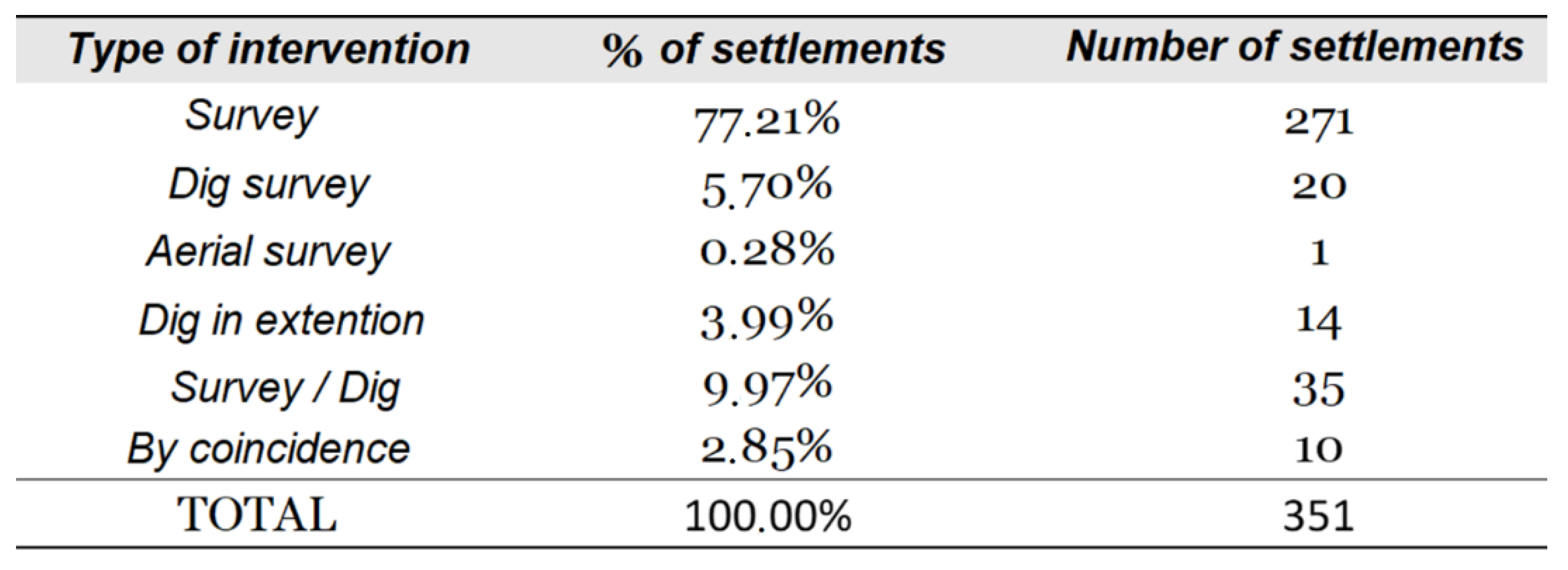
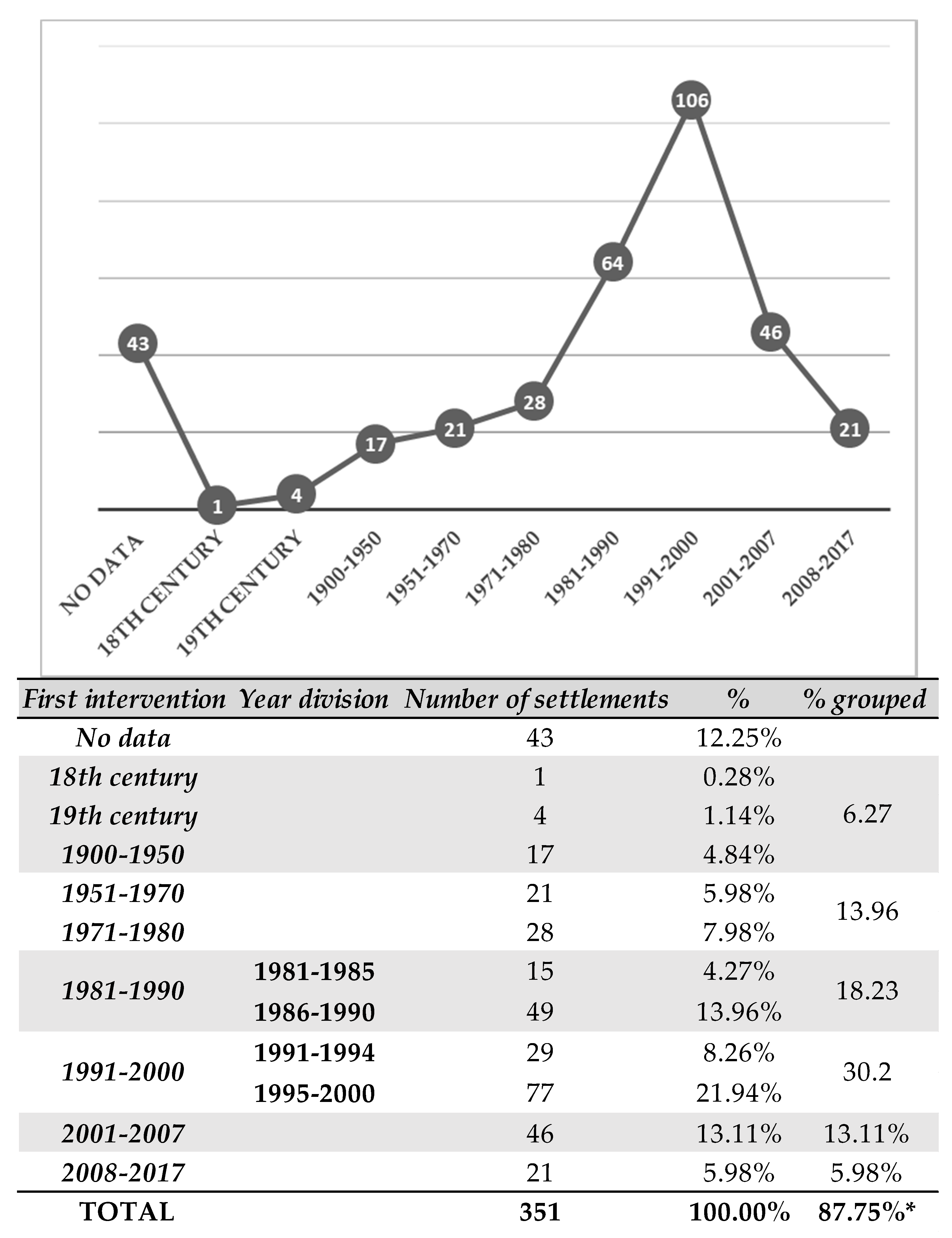
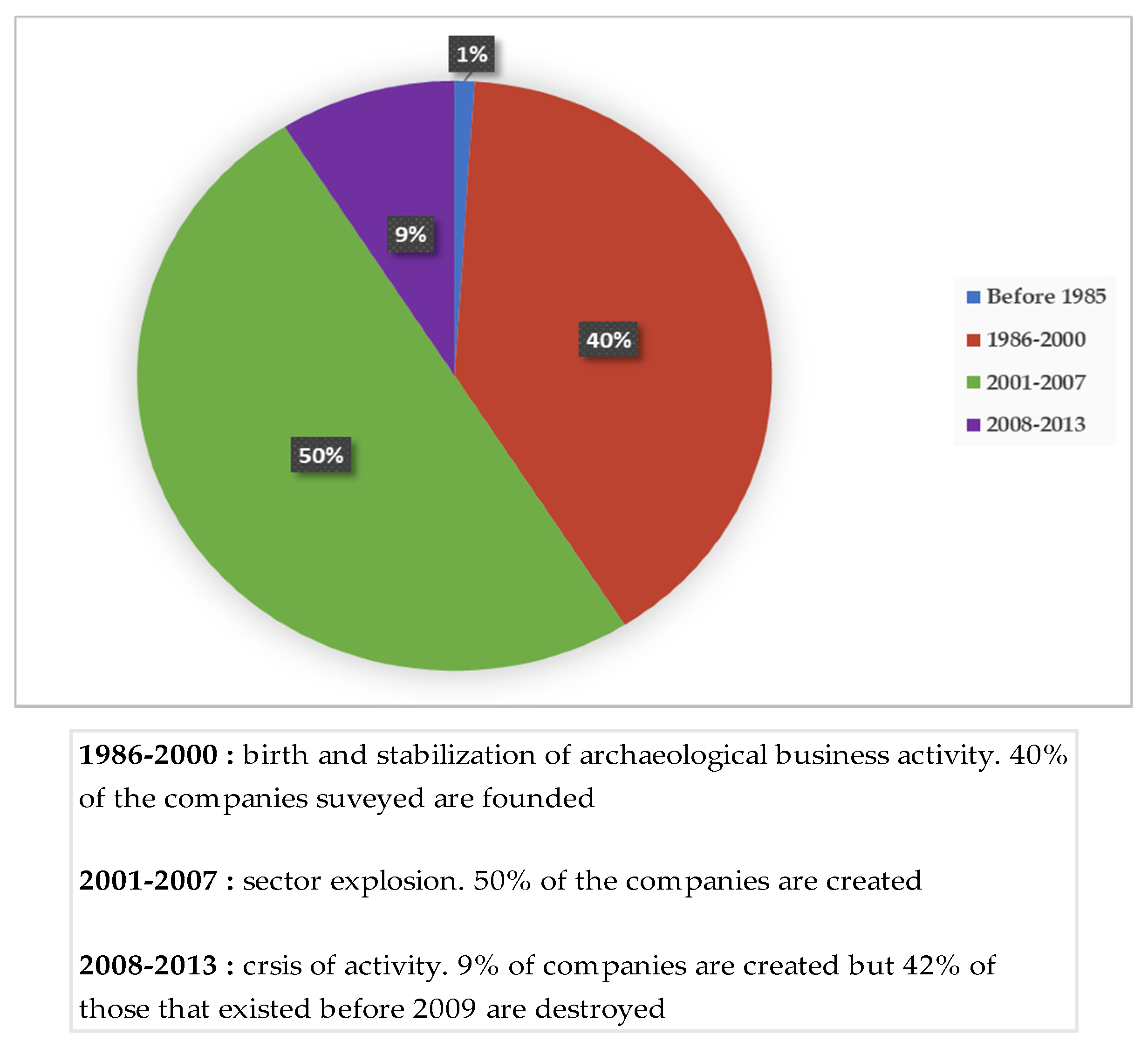
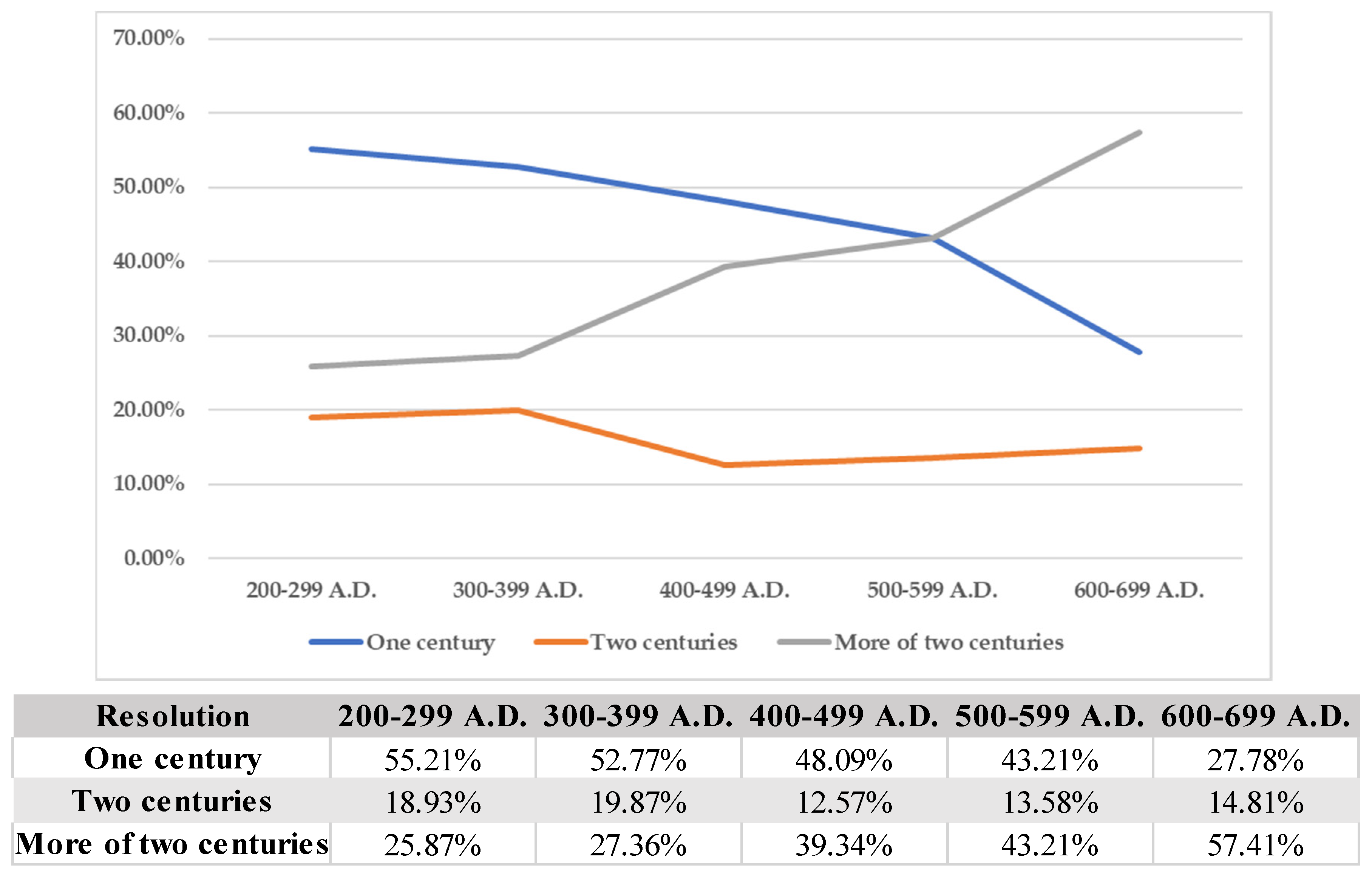
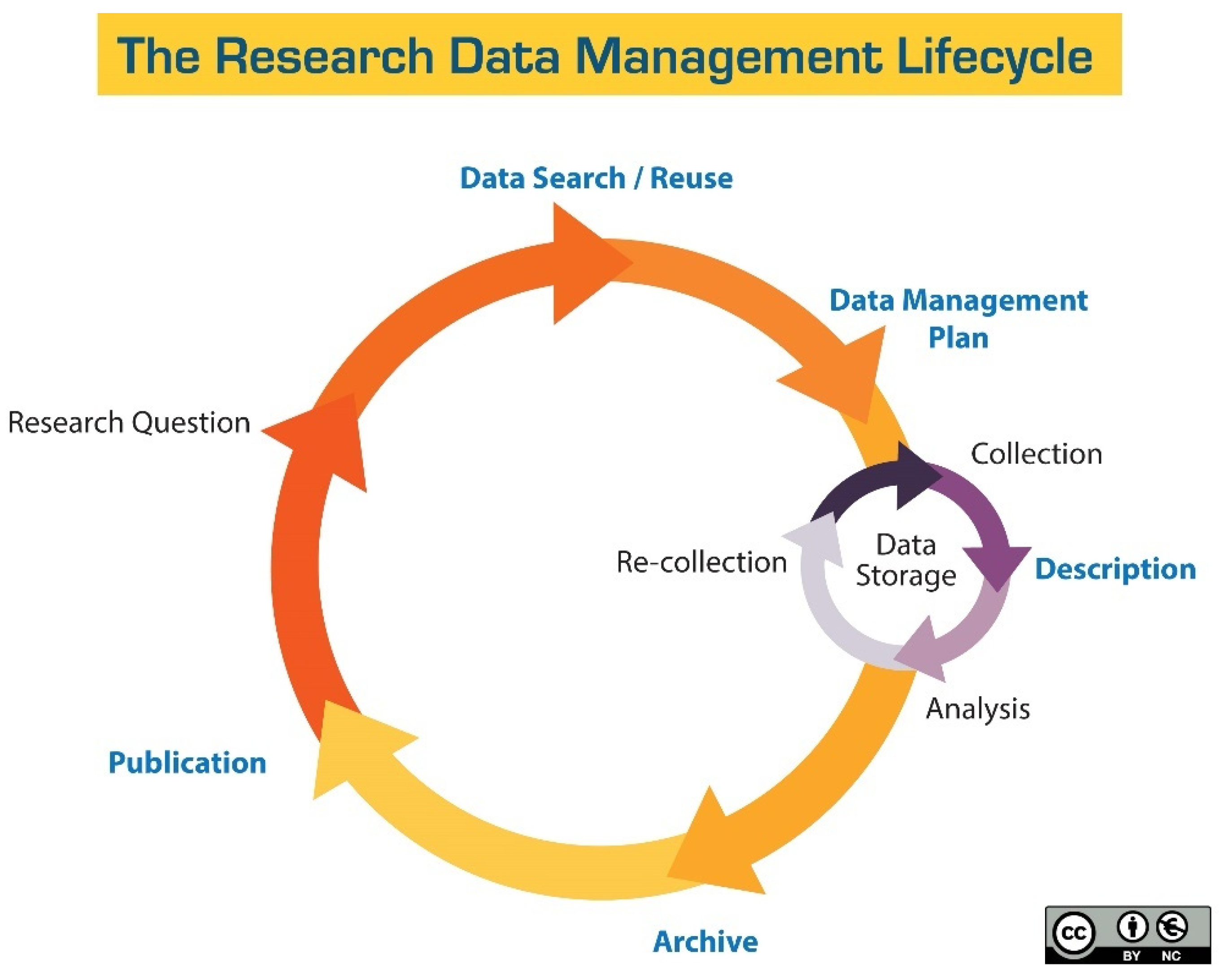
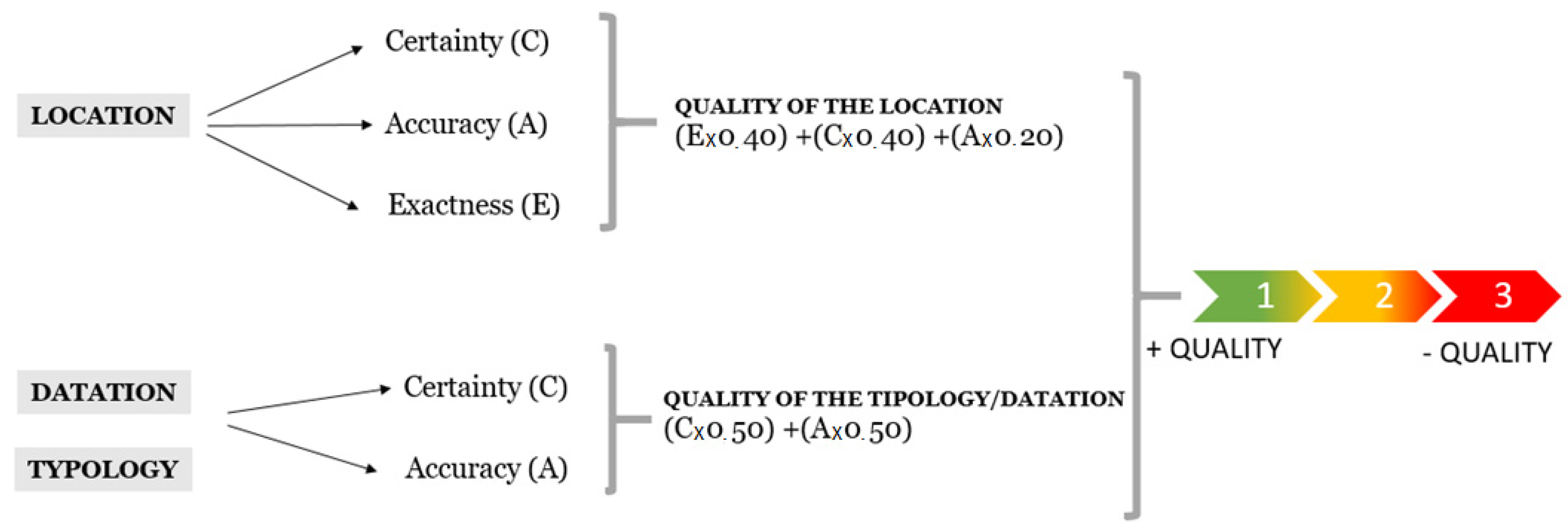
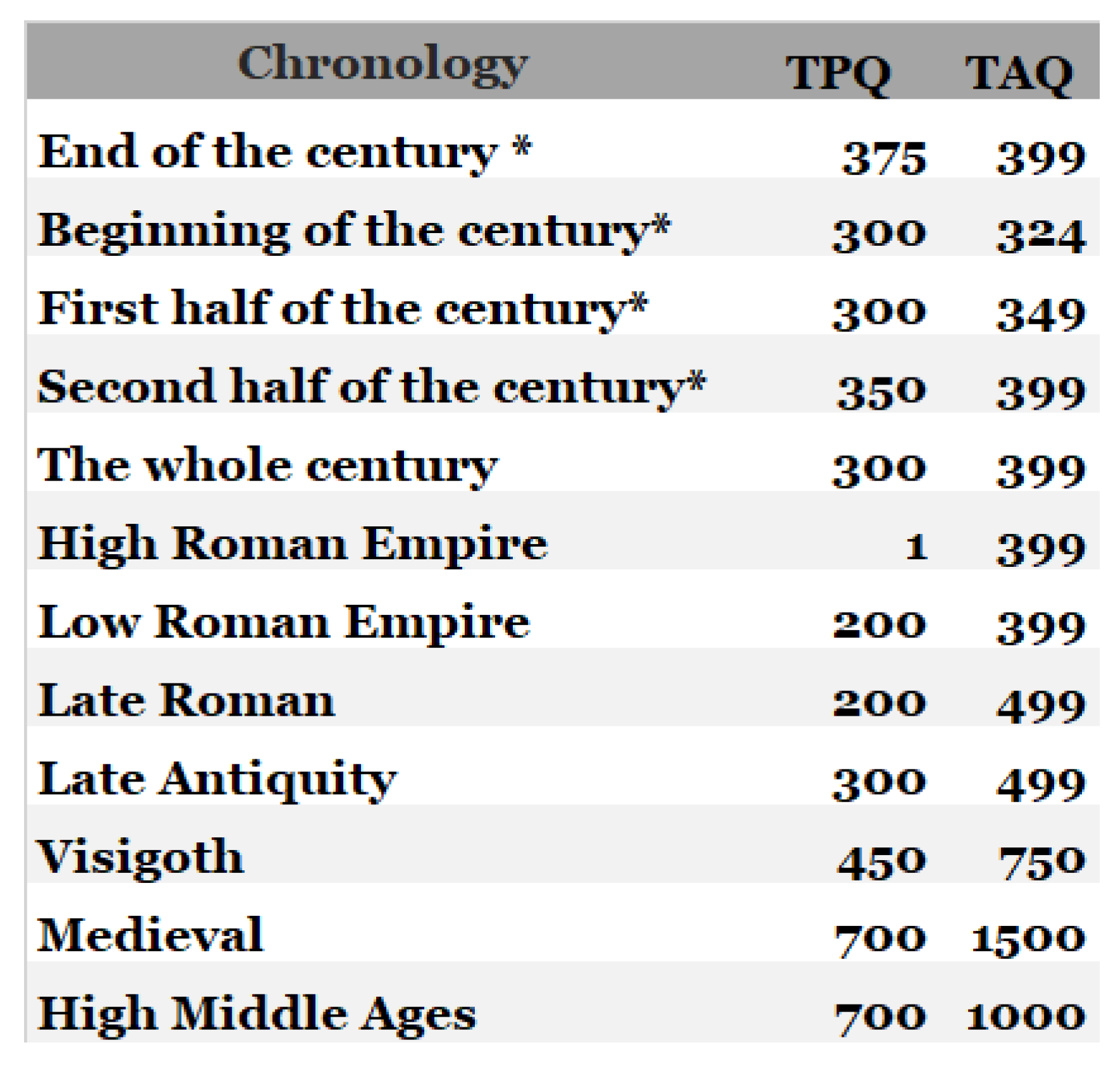
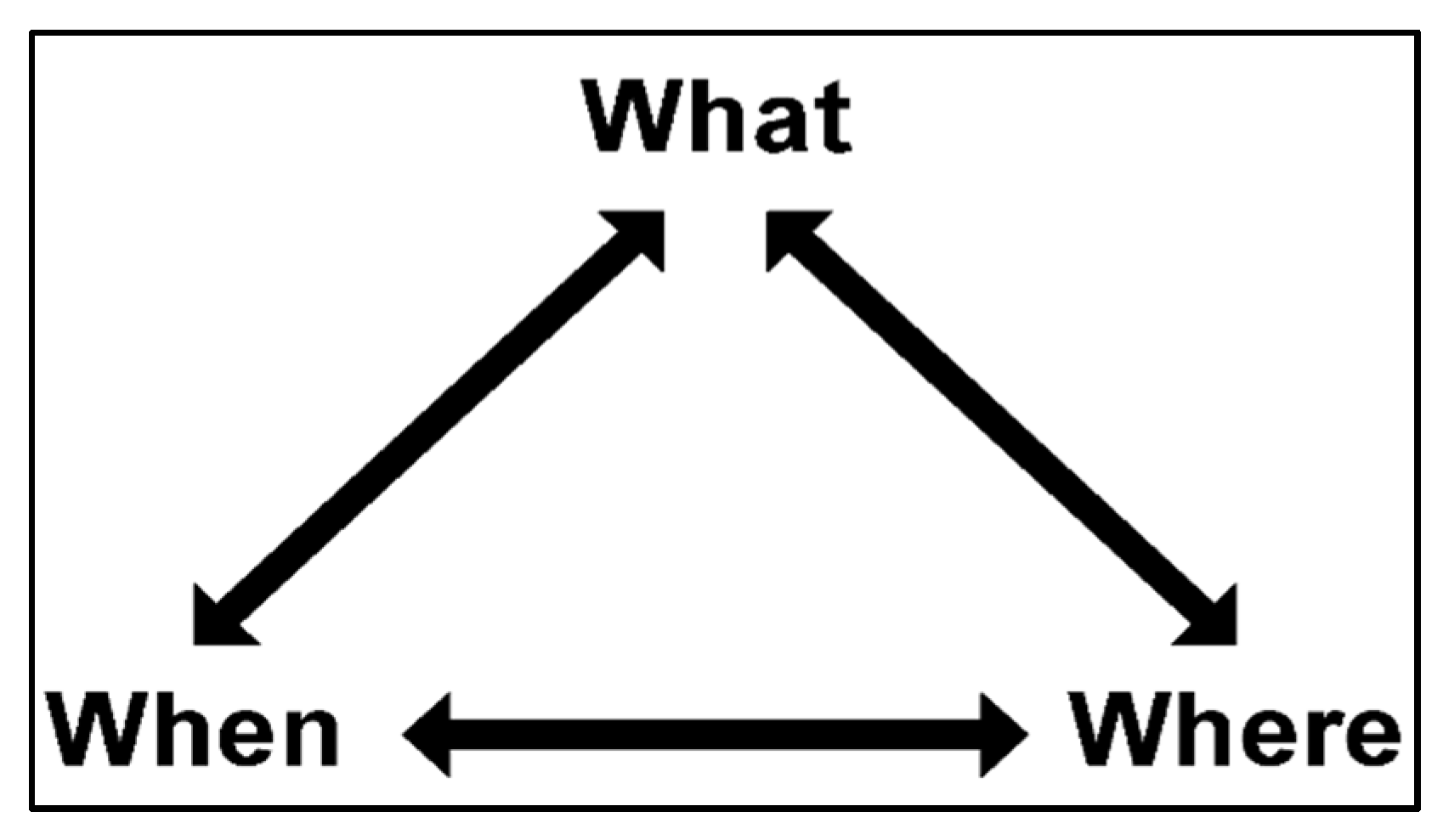
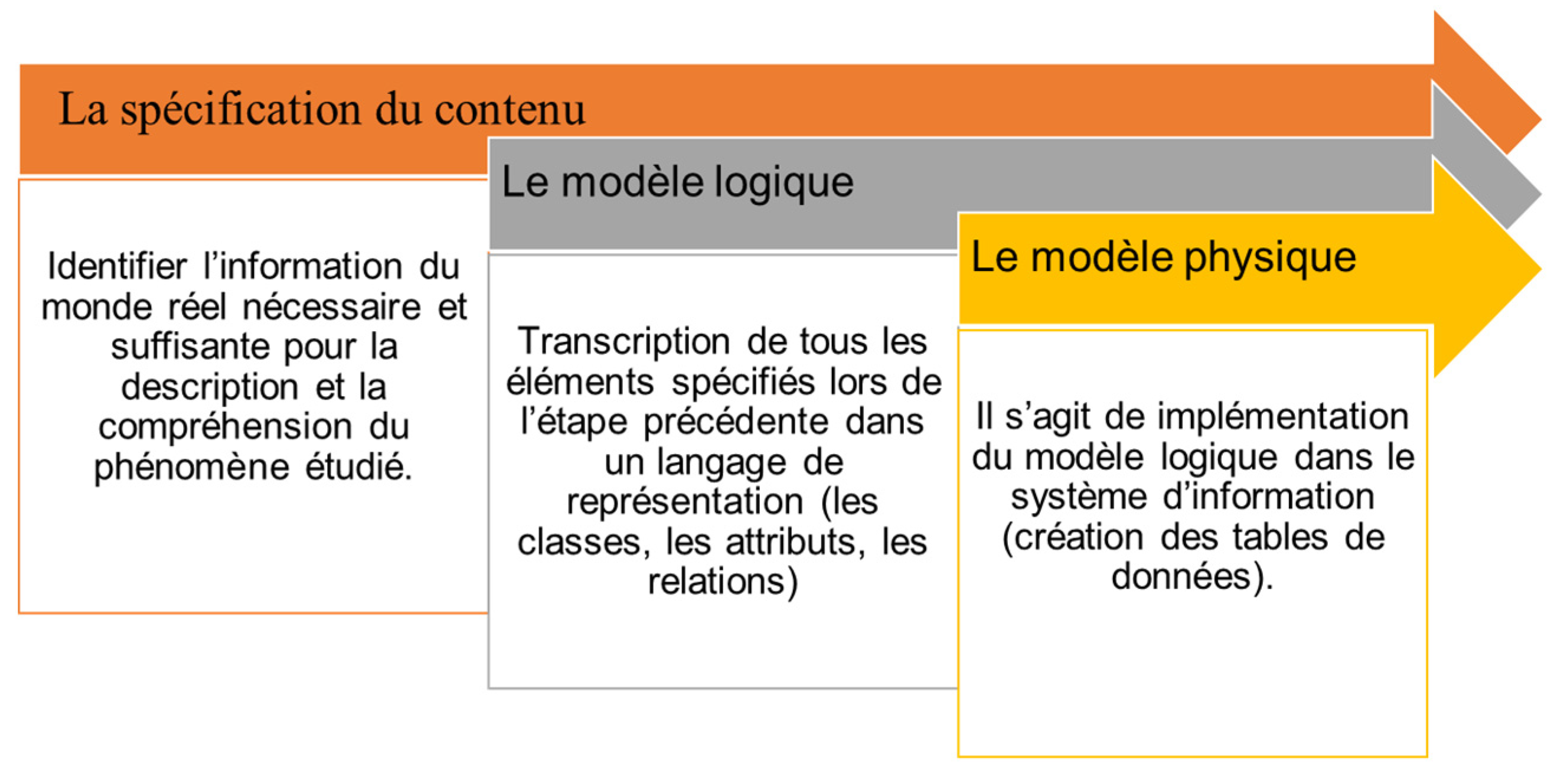
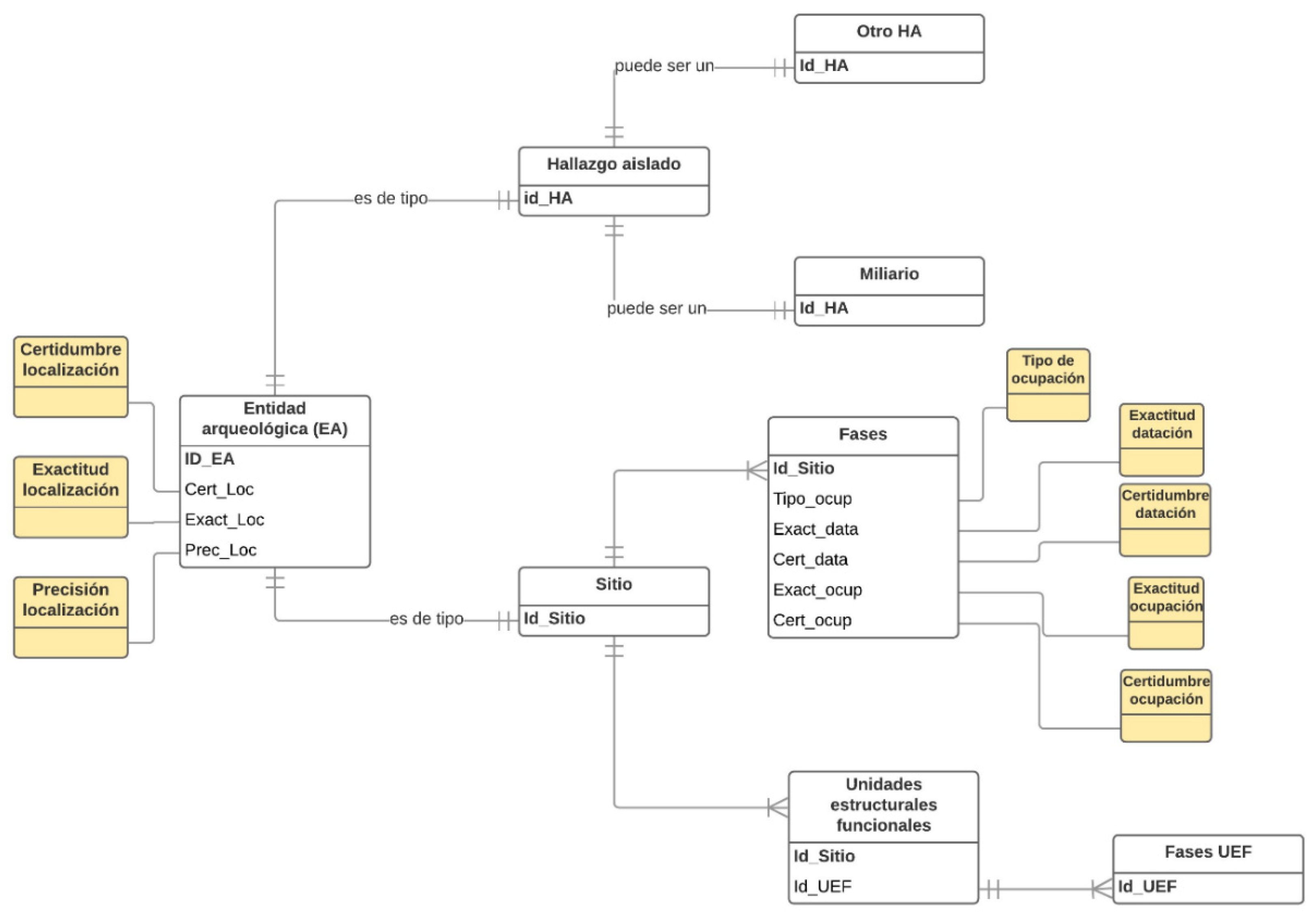
© 2020 by the author. Licensee MDPI, Basel, Switzerland. This article is an open access article distributed under the terms and conditions of the Creative Commons Attribution (CC BY) license (http://creativecommons.org/licenses/by/4.0/).
Share and Cite
Tobalina Pulido, L. Methodological Proposal for the Study of Temporal and Spatial Dynamics during the Late Period between the Middle Ebro and the Pyrenees. Information 2020, 11, 366. https://doi.org/10.3390/info11070366
Tobalina Pulido L. Methodological Proposal for the Study of Temporal and Spatial Dynamics during the Late Period between the Middle Ebro and the Pyrenees. Information. 2020; 11(7):366. https://doi.org/10.3390/info11070366
Chicago/Turabian StyleTobalina Pulido, Leticia. 2020. "Methodological Proposal for the Study of Temporal and Spatial Dynamics during the Late Period between the Middle Ebro and the Pyrenees" Information 11, no. 7: 366. https://doi.org/10.3390/info11070366
APA StyleTobalina Pulido, L. (2020). Methodological Proposal for the Study of Temporal and Spatial Dynamics during the Late Period between the Middle Ebro and the Pyrenees. Information, 11(7), 366. https://doi.org/10.3390/info11070366




